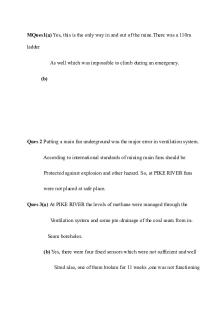Exercise 33 Pulmonary Ventilation PDF

| Title | Exercise 33 Pulmonary Ventilation |
|---|---|
| Course | Found Human Anat & Physio-Lab |
| Institution | Wichita State University |
| Pages | 1 |
| File Size | 45.7 KB |
| File Type | |
| Total Downloads | 59 |
| Total Views | 142 |
Summary
Pulmonary Ventilation...
Description
Exercise 33: Pulmonary Ventilation
Respiratory system supplies the oxygen needed to produce adenosine triphosphate (ATP) Removes carbon dioxide from the bloodstream Air moves from areas of high pressure to areas of low pressure ○ Boyle’s Law: Pressure of a gas in a closed chamber is inversely proportional to the volume of that container. Increase in Volume → Decrease in Pressure Decrease in Volume → Increase in Pressure
Pulmonary Ventilation: (Breathing) The movement of air between the atmosphere and the lungs that occurs when we inhale and exhale. Increase in Lung Volume = Decrease in Pressure → Causes air to ENTER the lungs. Decrease in Lung Volume = Increases in Pressure → Causes air to EXIT the lungs. Changing Thoracic and Lung Volume (Bolded muscles are used only with forced inhalation/exhalation) Muscles that increase lung volume and thoracic cavity: External Intercostals = Elevate ribs Sternocleidomastoids = Elevates the sternum Scalenes = Elevate 1st and 2nd ribs Pectoralis Minor = Elevates 3rd, 4th, and 5th ribs Diaphragm = Flattens when contracted Muscles that decrease lung volume: Internal intercostals = Depress ribs Abdominal muscles = Compress abdominal contents, increases abdominal pressure, and forces diaphragm superiorly ○ External oblique, internal oblique, transversus abdominis, and rectus abdominis Know Table 33.1 in lab book (page 556) Know Figure 33.1 in lab book (page 557) Know Table 33.2 in lab book (page 559) Know Figure 33.3 in lab book (page 559) Pressure Changes during Pulmonary Ventilation As thoracic cavity expands (increases volume) it pulls the parietal pleura out with it. Pleural cavity pressure increases → Decrease in intrapleural pressure ○ Pulls the lungs (visceral pleura) outward: caused by surface tension from pleural fluid. As lungs increase in volume: Alveolar pressure decreases to below atmospheric pressure ○ Causing air to enter the lungs. When thoracic volume decreases: Lungs size decreases Intrapleural pressure and alveolar pressure increase → Air leaves the lungs...
Similar Free PDFs

Exercise Workbook 33 AIS
- 56 Pages

Pulmonary
- 23 Pages

Mechanical-ventilation
- 2 Pages

Pulmonary Funtion Test
- 1 Pages

Pulmonary Embolism
- 1 Pages

Ques1 - ventilation system
- 2 Pages

Measuring Pulmonary Function Prac
- 18 Pages

Pulmonary Edema - T. Pittman
- 2 Pages

Chapter 10 Pulmonary system
- 17 Pages

Pulmonary embolism Concept map
- 2 Pages

Mechanical ventilation CM
- 2 Pages
Popular Institutions
- Tinajero National High School - Annex
- Politeknik Caltex Riau
- Yokohama City University
- SGT University
- University of Al-Qadisiyah
- Divine Word College of Vigan
- Techniek College Rotterdam
- Universidade de Santiago
- Universiti Teknologi MARA Cawangan Johor Kampus Pasir Gudang
- Poltekkes Kemenkes Yogyakarta
- Baguio City National High School
- Colegio san marcos
- preparatoria uno
- Centro de Bachillerato Tecnológico Industrial y de Servicios No. 107
- Dalian Maritime University
- Quang Trung Secondary School
- Colegio Tecnológico en Informática
- Corporación Regional de Educación Superior
- Grupo CEDVA
- Dar Al Uloom University
- Centro de Estudios Preuniversitarios de la Universidad Nacional de Ingeniería
- 上智大学
- Aakash International School, Nuna Majara
- San Felipe Neri Catholic School
- Kang Chiao International School - New Taipei City
- Misamis Occidental National High School
- Institución Educativa Escuela Normal Juan Ladrilleros
- Kolehiyo ng Pantukan
- Batanes State College
- Instituto Continental
- Sekolah Menengah Kejuruan Kesehatan Kaltara (Tarakan)
- Colegio de La Inmaculada Concepcion - Cebu




